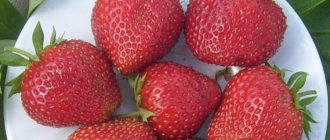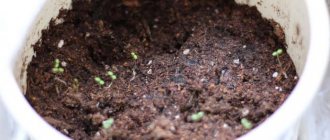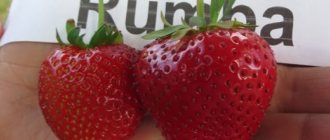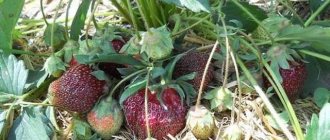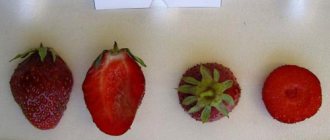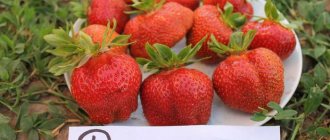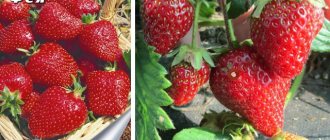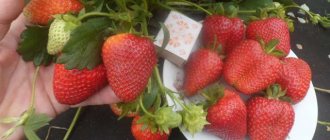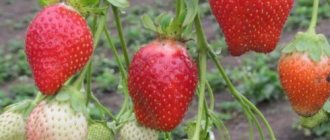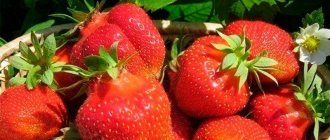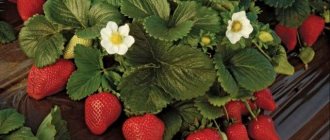Growing and care
When growing Evis Delight, you must adhere to certain agricultural techniques.
The assortment has its own characteristics and requires an individual approach. Watering should be regular but moderate. It is advisable to use root or drip irrigation and use warm rainwater. During the period of ovary formation, strawberries are watered every other day, in the evenings or in the mornings.
Loosening, weed control
More and more gardeners are growing strawberries on black agrofibre. Non-woven material allows you to reduce the frequency of watering and maintains a suitable soil structure. It will be possible not to resort to loosening the soil crust after watering. In addition, agrofibre prevents the development of weeds, allows air to pass through, and prevents the roots from freezing on cold days.
Removing a mustache
The variety produces an average amount of mustache. If you do not plan to propagate strawberries, they are removed with sharp pruning shears.
Strawberry Evis dolight is responsive to fertilizing. In spring, the plant is fed with mixtures containing nitrogen. These can be solutions of mullein (1:10), bird droppings (1:20) or urea (a tablespoon per bucket of water).
In summer, the plant needs additional fertilizing with fertilizers containing potassium and phosphorus. They will help restore strength for the next wave of fruiting.
Foliar feeding shows good results. A complex fertilizer is used, for example Plantafol, 10-15 g per 10 liters. water.
Pest and disease control
The originators pointed out the resistance of Evis Delight to powdery mildew, late blight and verticillium. Anthracnose poses a danger to the variety. It can be triggered by high air humidity.
To avoid diseases, it is necessary to control the quality of planting material, water the beds on time, ensure high-quality drainage during the rainy season, and observe crop rotation.
The variety requires preventive treatments with fungicides. You can use the drugs Oxychom or Fundazol. Spraying is carried out in early spring, before flowering or in late autumn.
Evis Delight strawberries are protected from insect pests using standard methods for the crop. This can be treatment with insecticides (Fufanon, Actellik) or the use of folk remedies.
Planting beds with plants that repel insects: calendula, marigolds, fennel has a good effect.
Preparing for winter
At the end of the last harvest, the strawberries are weeded and the bushes and soil are treated with copper-containing preparations. Damaged and diseased leaves are removed. In the southern regions, Evis Delight does not need shelter, as it is resistant to low temperatures.
In cold winter conditions, the beds are covered with coniferous spruce branches and agrofibre. If there are no rodents in the area, you can use straw and dry leaves. At the first thaw in spring, the beds are opened. For Evis Delight, spring frosts are not as dangerous as damping off of the roots.
Diseases and pests
This hybrid is highly resistant to most diseases that affect other varieties of strawberries and garden strawberries. But Alice Delight’s resistance to anthracose is below average.
The first symptoms of this disease are the appearance of brown spots on the antennae. Subsequently, the spots spread to the sepals and fruits. The affected parts of the plants dry out and die.
It is important to know!
The most comfortable conditions for the development of anthracosis are high air humidity or a long period of drought.
To prevent the development of this disease on the strawberry hybrid Evis Delight, the following growing conditions must be observed:
- select only high-quality seedlings for planting;
- regularly apply fertilizer to strawberry bushes;
- adhere to crop rotation requirements when choosing a site for planting Evis Delight strawberries;
- preventive treatment of plants and soil with fungicidal preparations.
Advantages and disadvantages of strawberry Delight
Among the advantages are:
- high yield;
- breeding in open ground, greenhouses and under film covers;
- large fruit;
- rapid adaptation in unsuitable climatic conditions;
- resistance to frost and sudden temperature changes.
The strawberry variety belongs to the remontant group, which allows you to harvest a good harvest in neutral daylight conditions. Gardeners, according to observations, identified two shortcomings. The first is poor resistance to diseases such as anthracnose. The second is low reproductive ability.
Description of the variety
The birthplace of the berry is Great Britain, where the culture was developed in a country characterized by rain and fog. Strawberries contain a lot of sugars, which makes them several times superior to other varieties. It produces several harvests in one season, which does not negatively affect the taste of the berries, their size and aroma.
Peduncles are erect and very strong. Thanks to this, the heaviest berries, which are distinguished by their large weight, are retained.
The bushes reach a height of 30-35 cm, on which a large number of flowers with large petals are formed. Evis Delight is able to withstand winter cold, as it is resistant to low temperatures.
The nuances of growing a plant
The key to obtaining a large harvest depends on many factors. It all starts with choosing the right location. Agricultural technology plays a big role. Failure to follow the rules will not give the desired result. It is this stage that leads to receiving negative reviews.
Selection and preparation of a landing site
Strawberry bushes are located on the southwest side. The site should be level with slight upward development. Avis Delight is not grown in the northeast and lowlands. Groundwater on the site must flow at a depth of at least 0.6 m.
The hybrid needs stable daylight, so planting in dark places is not recommended. Bad areas for strawberries are the shade of spreading fruit and berry trees. The root system of trees prevents the development of strawberries.
Preparation of planting material
Strawberry rosettes, ready to be planted in a new place, are not watered for 3-5 days. Only before the procedure itself is abundant watering carried out. Saturation with moisture helps to free the socket from the container. The peat cup is planted directly in a new place without affecting the root system.
Landing rules
For 1 sq. m of land, no more than 4 bushes are planted. 0.3 m of free space is maintained between the bushes. Between rows - 0.5 m.
Rosettes ready for planting are placed in pre-dug holes and then sprinkled with soil. The final stage is to water the plant abundantly. During planting, care should be taken to ensure that the root system is not damaged. The ability to take root in a new place and the speed of growth and development depend on this part of the plant.
Planting and caring for garden strawberries Evis Delight
Growing strawberries is associated with compliance with agrotechnical rules. Culture has distinctive features that require a special approach.
Selection and preparation of a landing site
When planning plantings, special attention is paid to site selection. The bud formation, flowering and, as a consequence, fruiting of the hybrid depend on this.
For the Evis Delight variety, a flat area in the southwest with a slight upward development, not exceeding 2 - 3 m, is suitable. Growing strawberries in the northeast, in the lowlands, with a groundwater depth of less than 60 cm, is excluded.
The Evis Delight hybrid needs stable daylight, so it is not planted in shaded areas.
When observing crop rotation, take into account that Evis Delight strawberries can grow after greens, radishes or legumes, but tend to wither in soil preceded by onions, celery, and pumpkin.
The proximity to vegetable crops is also not always favorable for the strawberry variety Evis Delight. Landings in the immediate vicinity are excluded:
Strawberries should not be planted in the shade of spreading fruit and berry trees. The root system of such crops can interfere with the development and growth of berry bushes.
The soil for planting Evis Delight must meet the following requirements:
- in structure - to be light, loose;
- in terms of acidity level – have values from 5 to 6.5 pH;
- settled after digging.
To improve the quality of the soil, 2 weeks before planting, add up to 6 kg of organic fertilizers and about 40 g per 1 sq. m. cm soil mineral complexes.
Preparation of planting material
As a rule, gardeners have 2 ways to grow garden strawberries: buying shoots in specialized departments or growing seedlings at home.
The Evis Delight variety is sold as seedlings of 3 in packaged peat pots. When planting seeds for seedlings, the ripening time should be taken into account.
Seeds can be purchased in specialized departments or collected independently. To do this, the skin of the berry, dried in the sun, is laid out on a smooth surface and the seeds are carefully extracted from it using a wooden stick.
To grow seedlings at home, you must provide:
- temperature regime not less than +24 °C;
- daylight hours at least 12 hours;
- drip irrigation, ventilation of shoots.
Strawberry rosettes are not watered for 3-4 days before planting. Before carrying out the procedure, water thoroughly to free the outlet from the cup.
When planting a peat cup, no additional preparations are required.
Landing rules
It is customary to plant Evis Delight strawberries according to a certain scheme, according to which the qualities of the variety, the possibility of growth and the characteristics of fruiting are taken into account.
Bushes are planted at the rate of 4 bushes per 1 square meter. Standard indentation indicators:
- between bushes - about 30 cm;
- between rows - about 50 cm.
The rosettes are placed in small holes and sprinkled with earth. Then they are compacted and watered. When planting, care is taken not to damage the fragile root system, since the plant’s ability to adapt to new growth conditions depends on it.
Watering and fertilizing
Strawberries Evis Delight require regular watering. At the same time, strawberries do not like waterlogged soil.
Basic rules of irrigation:
- alternating drip and root irrigation;
- use of settled water.
In spring, the plant is fed with complexes containing nitrogen. In summer, strawberries require additional feeding with phosphorus and potassium. This is due to the need to increase strength for repeated fruiting.
How to care for strawberries (video)
Large-fruited strawberries from Sashenka F1 seeds are distinguished by the bush’s vigor and resistance to diseases and pests. The plant contains many tasty and sweet fruits that tolerate transportation well and are suitable for fresh consumption and processing. During the season, the yield reaches 2 kg per bush. Strawberries bear fruit right up to frost.
After looking at photos of different varieties and reading reviews from experienced gardeners, you can choose the best options for yourself and enjoy delicious, healthy berries almost all year round.
Reviews
Of my three varieties: “Queen Elizabeth 2”, “Albion”, “Evis Delight”, the last one is the sweetest and most aromatic.
I live in Crimea. In 2021, I have Evis Delight bearing fruit until December!
Evis Delight strawberries are chosen by farmers because of their trouble-free transportation and the ability to store the fruit for a long time. Gardeners respect the berry for its extraordinary sweetness and intense aroma. If you follow agricultural technology, Evis Delight will produce a stable harvest in any climatic region.
Early ripening
Garden strawberries of early ripening varieties are very popular; they have excellent taste, high yields and rapid ripening of fruits. Early ripening varieties include Honey, characterized by early ripening. The berries are distinguished by excellent taste, classic even shape, and rich, bright color. Honey is characterized by resistance to leaf diseases, but sometimes the root system can be affected.
Another interesting option is Christine. It is characterized by the presence of large berries of a bright, rich orange-red hue. The taste of the fruits is very delicate, quite sweet, with a slight sourness. Christine is one of the most resistant varieties that can withstand significant temperature changes and are almost not susceptible to any diseases. For full growth and fruiting, good watering and fertilizing are sufficient.
Clary's strawberry, just like any other variety of strawberry, has excellent taste, is hardy and disease-resistant. It has very interesting unusual elongated fruits with a somewhat elongated conical shape. Clary has very good winter hardiness, so it is perfect for growing in northern regions.
Recommendations for caring for the variety
It has individual nuances that must be taken into account if a person wants to get a good and stable harvest.
Watering rules
The berry variety needs regular and abundant watering. In this case, there should be no waterlogging of the soil. Irrigation rules are as follows:
- watering alternates with drip and root;
- settled water is used;
- it shouldn't be cold.
Watering increases during fruit formation. The soil is saturated with moisture daily. At the same time, make sure that there is no stagnation of water.
Fertilizers and fertilizers
In spring, the crop is fertilized with complexes containing nitrogen. In summer, the emphasis is on potassium and phosphorus. In the latter case, the substances give the plant strength to bear fruit again.
Mulching and loosening
Covering the soil with mulch reduces the frequency of watering, as well as the growth of weeds. The procedure has another important advantage - it improves the soil structure for growing strawberries. Mulch can be inorganic and organic:
- straw;
- coke shavings;
- agrofibre;
- humus;
- hay;
- needles.
When caring for strawberry beds, do not forget about loosening. The procedure is carried out not only after watering, but also after precipitation. Loosening is done between the bushes, trying to create neat grooves.
Preparing for winter
It usually begins after harvest. Weeds are removed from the garden beds, bushes are treated with herbicides and pruned. Strawberries should not have many leaves, as this risks freezing. Branches with signs of disease, dry and damaged must be removed.
Then they move to the shelter. The needles are used for regions with extreme low temperatures. The fallen snow also serves as cover for the strawberries.
Description
Large-fruited strawberry Evis Delight is a plant that can produce several harvests per season. A distinctive feature of this strawberry variety is its erect peduncles, capable of holding even fairly large berries suspended.
Patent description of the strawberry variety “Evis Delight”:
- large vertically growing bush 38 cm high;
- large uniform fruits;
- the berries are mostly conical, a small part may be wedge-shaped;
- bright red color of berries;
- smooth shiny skin;
- long, vertically standing peduncles;
- medium and late ripening of berries;
- repeated fruiting over a long period of time.
The patent provides not only a verbal description of the Evis Delight strawberry variety, but also a photo.
Description of strawberry fruits of the Evis Delight variety:
- length-width ratio: length greater than width;
- size: large;
- prevailing shape: cone-shaped;
- aroma: strong;
- difference in shape between first and second harvests: moderate to strong;
- difference in shape between the berries of the first and third harvests: moderate;
- stripe without achenes: narrow;
- color of ripe berries: bright red;
- color uniformity: uniform;
- skin glossiness: high;
- seed shape: uniform, slight convexity;
- position of receptacle petals: uniform;
- color of the upper surface of the receptacle: green;
- color of the lower surface of the receptacle: green;
- receptacle size in relation to berry diameter: usually smaller;
- pulp hardness: moderate;
- Flesh color: The internal color of the flesh at the outer edges of the fruit surface is closer to bright orange-red, and the inner core is closer to red;
- hollow center: moderately expressed in primary fruits, weakly expressed in secondary and tertiary berries;
- seed color: usually yellow, red when fully ripe;
- Flowering time: mid to late;
- ripening time: medium to late;
- berry type: neutral daylight hours.
Other characteristics of Eves Delight: the ability to reproduce is low, during the growing season it forms only 2 - 3 additional rosettes; frost-resistant: can winter without problems in the regions of Moscow and the Kamchatka Territory. The only requirement for wintering is shelter. In the Central regions of Russia and Ukraine there is enough agrofabric for Evis. Farther north you will need more reliable cover.
The patent description of the Evis Delight strawberry indicates the resistance of the variety to diseases such as powdery mildew, late blight and verticellosis.
Evis was created as a competitor to another common strawberry variety in the UK, Albion, therefore all the characteristics of Evis in the patent are given in comparison with Albion. In general, Eves Delight is superior to Albion in taste and technical characteristics, but inferior to it in yield.
The yield of remontant strawberries “Evis Delight”, due to long fruiting, is up to 700 g of berries from one bush. Even when ripe, the flower stalks hold the berries above the leaves, making berry picking very convenient.
The yield of the Evis Delight strawberry variety depends on the planting density. The theoretical reaches up to 1.5 kg per bush. The estimated yield at a planting density of strawberry bushes of 8 pcs/m² is 900 g per bush. With a density of 4 bushes per 1 m² – 1.4 kg. The estimated average weight of one berry is 33 g.
Afterwards, the bushes need to be replaced, as the berries on them become smaller.
Reviews of the Evis Delight strawberry variety confirm that Evis does not have any serious differences from other varieties of strawberries.
Bushes are usually planted in March-April. After the bushes take root, grow and bloom, the first flower stalks are plucked out, since the plants have not yet gained strength, and early fruiting will destroy the strawberries. In beds reserved for propagation, flower stalks are plucked out so that they do not interfere with the plants producing new rosettes on their tendrils.
In open ground, strawberry bushes are planted at the rate of 4 bushes per square meter. Scheme: 0.3 m between plants, 0.5 m between rows. With more intensive agricultural technology, strawberries are planted in tunnels.
Due to intensive and long-term fruiting, Evis strawberry bushes require a significant amount of fertilizing. And there is one pitfall here: it is necessary to provide the plant with sufficient nutrition without adding a large amount of nitrogen during the flowering and fruiting period.
During the fruiting period, strawberries are provided with sufficient watering and potassium-phosphorus fertilizers.
Organization of competent care
In order for strawberries to produce a consistently high yield, it is necessary to properly care for the planted plants.
Regularity of watering by season
It is necessary to water strawberries regularly, making sure not to over-moisten the soil. Only settled water is used for irrigation. You should alternate drip irrigation with adding water to the root of the plant.
Immediately after planting, the seedlings are watered daily. 2 months after planting, they switch to watering once every 3-4 days. During the period of fruit formation, strawberries need to be watered daily. On hot days, watering is done 2 times a day: in the morning and in the evening.
What and how to feed bushes
In spring, nitrogen-containing fertilizers must be added to the soil. They stimulate plant growth. In summer, during fruiting, fertilizing containing potassium and phosphorus is required. They are added every 10-14 days. It is also recommended to add organic matter: bird droppings or cow manure diluted in water for irrigation. In late autumn, compost is added to the soil.
Weeding and loosening the soil
After watering or rain, the soil must be loosened and weeds removed. Loosening improves the soil structure and promotes aeration of the plant roots.
Mulching
After loosening, the soil is mulched to reduce moisture evaporation and create an obstacle to the growth of weeds. Straw, humus, coconut substrate, mown grass, pine needles, roofing felt, and agrofibre are used as mulch.
Shelter for the winter
The Evis Delight variety is characterized by good frost resistance. However, in regions with a cold climate, it must be covered with pine needles, spruce branches, fallen leaves or straw for the winter, and covered with snow on top to protect it from severe frosts.
Preventative treatments
To prevent diseases and pest damage, strawberries are treated with solutions of fungicides and insecticides. Treatments are carried out in the spring, before flowering and in the summer, during the period of fruit ripening.
Care and feeding
Caring for this plant includes the following:
- regular watering;
- weed removal;
- feeding;
- mulching;
- inspection of the plant to assess its health; if symptoms of disease are found, treatment must be taken.
Weeds must be removed regularly, otherwise the growth and ripening of the crop will be complicated. Feed once every 10-14 days . Mullein and chicken droppings are suitable for this. Mulching is carried out once every 8-10 days.
Strawberries Evis Delight: agricultural cultivation technology
The main thing when planting seedlings of this hybrid is the correct choice of site. It should be level, located in the southwestern part of the garden, where groundwater does not come close to the soil surface. It is not recommended to grow this strawberry in lowlands.
Bushes of the Evis Delight variety require regular lighting during the day, so the planting site should not be shaded.
The soil should be loose and fertile, well permeable to moisture and air, and have neutral acidity.
To increase the fertility of the site, 10-12 days before planting the seedlings, organic matter (up to 6 kg per square) and mineral fertilizers - at least 40 g per 1 m 2 - are added to the soil for digging.
Photo of strawberry Evis Delight
Planting scheme for Evis Delight strawberry bushes - no more than 4 plants per square
, the distance between which in the rows is up to 0.3 m, and the row spacing is 0.5 m.
The seedlings are placed in planting holes, covered with nutrient substrate, lightly compacted and watered well.
To properly water strawberries, it is better to arrange drip irrigation. When applying root irrigation, filtered warm water should be used.
During the ripening of crops, it is recommended to water the Evis Delight hybrid daily. After watering, it is recommended to loosen the soil, removing the resulting crust and at the same time destroying weeds. After loosening, the tree trunk circles are mulched. In this case, the moisture evaporates more slowly, so you can water this berry crop less often.
As a mulching material for strawberries, Evis Delight can be used:
After the last harvest is harvested, the crop begins to be prepared for winter.
Be sure to trim and burn all foliage. If the region has harsh winters, then the bushes should be covered with a thick layer of pine needles, and on top with fallen snow. With such shelter, Evis Delight strawberries can easily tolerate temperatures dropping to -30 degrees Celsius.
This remontant hybrid bears fruit throughout the summer; ripe berries are collected regularly so that new ovaries form in their place. Evis Delight strawberries are grown in one place for a couple of seasons, then the plantings need to be renewed.
Strawberry Evis Delight: characteristics and description of the variety
This hybrid is a day-neutral strawberry variety and is capable of bearing fruit several times per season. Erect peduncles are very strong and strong, so they are able not to bend under the weight of large ripening fruits.
The bushes of the variety are compact, but quite tall, they can reach a height of 35-37 cm. The foliage is quite large, shiny, slightly wrinkled, of a rich emerald hue. The plant produces an average number of peduncles, each of which can ripen up to 6-8 large berries.
Evis Delight strawberry flower stalks are erect, grow higher than the leaves, and do not bend to the ground under the weight of ripe berries, so the fruits always remain clean. Evis Delight's whisker formation is average, sufficient to renew the plantation
.
Strawberry Avis Delight - video
The ripening berries are large in size, almost identical in size, have a conical shape (sometimes wedge-shaped fruits ripen). The skin is smooth, shiny, deep red. The pulp is medium density, without voids, sweet, juicy. Weight of ripe berries – 30-35 g.
During the summer season, 3-4 harvests are harvested from the Evis Delight strawberry plantation.
The collected fruits tolerate transportation well over fairly long distances, do not “spread” or release juice during transportation, and are stored well for several weeks.
The strawberry variety Evis Delight is adapted for cultivation in difficult weather conditions and is highly resistant to frost.
, therefore, in regions where a sufficient amount of snow falls in winter, it can winter without shelter at temperatures down to -28-30 degrees Celsius.
a brief description of
Advantages of the variety
- large fruits;
- sweetness and rich piquant aroma;
- high productivity rates;
- the ability to harvest all summer;
- suitable for open beds and greenhouses; high frost resistance;
- adapts to difficult climatic conditions;
- The good taste of the fruit is preserved even in rainy weather.
Disadvantages of the variety
Despite rave reviews from gardeners, the assortment has disadvantages:
- low immunity to anthracnose and spotting;
- planting must be renewed every 2 years;
- fruits crack after rain
The berries of Evis Delight are so tasty that gardeners are ready to protect them from diseases and find ways to renew their plantings every two years.
When growing Evis Delight for personal consumption, the fruits should be kept on the bush for 2-3 days after complete coloring, the taste will be much more sugary, and the aroma will intensify. If it is necessary to transport the crop over long distances, then the berries are collected at the stage of technical maturity
The development of the plant, winter hardiness and, ultimately, productivity depend on the correct choice of site. Evis Delight will grow well on a flat area on the southwestern or southern side of the site with a slight slope, which will ensure drainage of rainwater. Lowlands and shading are contraindicated; stable daylight hours are important for strawberries.
The hybrid will grow well after dill, radishes and peas. Will be lethargic in areas where celery and pumpkin grew. Tomatoes, eggplants and peppers should not grow in close proximity.
The soil should be loose, with an acidity level of 5.2 - 5.5 pH. After digging, at least 30 days must pass for the earth to settle. To improve the quality of the soil, organic fertilizers are added to it in an amount of 8-10 kg. per square meter of area, with the addition of 200 g of wood ash or 50 g of superphosphate.
Taking into account the developmental characteristics of Evis Delight bushes, they are planted at the rate of 4 plants per 1 square meter. If a strip planting system is chosen, 30 cm is left between plants and 0.5 m between rows. After planting, the plant is watered and the bed is mulched.
When planting, you need to make sure that the roots do not bend upward and the heart is not buried
Repairers
Due to the fact that there are remontant varieties of strawberries and wild strawberries, you can enjoy tasty and sweet berries from early spring until the onset of frost.
Remontant garden strawberries can decorate not only your summer cottage and vegetable garden, but also your balcony.
A new version of garden strawberries is Evis Delight. It stands out for its improved taste and preservation. Avis Delight significantly outperformed other strawberry varieties. The berries are dense, fleshy with excellent taste and aroma. Characterized by its ability to withstand drought and heat. In addition, it is resistant to pests and diseases.
Elan is a completely new species that was bred relatively recently by Dutch breeders. This strawberry variety is different:
- high resistance to diseases;
- excellent taste;
- increased level of productivity.
Another additional advantage of Elan is that it can bear fruit before the most severe autumn cold. On each Elan strawberry bush there are many tendrils and peduncles, abundantly strewn with fairly large and fragrant fruits.
Despite the fact that Elan bears fruit almost all year round, the fruits retain their excellent taste both during the warm summer period and during the severe autumn cold season.
Another excellent quality of Elan is frost resistance. If you grow such strawberries in greenhouses, you can get a harvest all year round.
Characteristics of the berry
Strawberries are formed quite large in size and ripen quickly. The berries are large with a rounded conical shape. Painted bright red. The peel has a shine and is distinguished by its smoothness.
The flesh is dense and not soft. The inside of the strawberry is as red as the outside. People who have tried the variety note a rich strawberry taste. It has a strong strawberry aroma, which is much stronger than other varieties.
One bush produces from 1.5 to 2 kg of berries per season. One berry weighs on average 20-30 g. With proper care, the size of the berries increases.
Cases have been recorded when individual specimens reached 50 g.
- large leaf plate;
- wrinkling is weakly expressed;
- color - dark green.
Mustache formation is characterized by an average degree. But their number is not enough for mass reproduction. One bush produces only 3-4 rosettes.
How to propagate the variety?
New shoots are produced using tendrils. One bush forms 3-4 rosettes. Propagation by seeds is also possible, but this method requires more time and effort.
The antennae are medium in size and colored light green. With proper care, the rosettes take root quickly, forming a strong root system. They remain on the surface of the earth; deep placement is contraindicated.
Dividing a bush is very popular because it involves simple and easy steps.
Review: Strawberry seedlings Search "Evis Delight" - the sweetest variety of strawberry
I bought remontant strawberries of the Evis Delight variety in 2015. There are five seedlings, packed in plastic “snails” with soil in a cardboard box. This variety is suitable for growing in pots, all the necessary information is on the packaging.
I planted the seedlings in April in 5-liter pots, and now the month of September is already here, the bushes have grown, there is a lot of foliage, a bunch of mustaches and not a single flower. I was worried, I read “fairy tales” about “male” bushes, I began to write questions to the manufacturer, and they answered me that if you bought seedlings in branded packaging in a chain of stores (not from your hands), then you don’t have to worry, we have very strict quality control and we are responsible for our products. I began to wait and by October my strawberries bloomed, set a bunch of berries, but they didn’t have enough sun and in November I had a whole bunch of green berries, so in the year of planting I didn’t manage to eat the berries, maybe it was not properly cared for. I sent it to the garden beds for the winter (planted it in the ground).
In 2021, strawberries produced a good harvest (twice per season in June and September) and many runners. Of course, I doubt that it’s possible to collect three kilograms from a bush - that’s two buckets from five bushes - I haven’t had such a harvest. It seems to me that I collected no more than one and a half kilograms from the bush in two fruitings, but it is impossible to verify this; there were 5-10 berries per day. Five bushes are of course very few, we didn’t even have enough to eat. On the wall of the temporary hut
The big disadvantage of growing in pots is that it is impossible to “land” the babies, and they were all thrown away, well, a couple of them grew to the ground, fortunately the suspension of one of the pots could not stand it, I put the pot on the ground.
And at the end of 2021, snow fell very early and unexpectedly, and I did not have time to prepare my strawberries for winter. But the weather was unstable, sometimes severe frosts, sometimes thawed. My flowerpots were hanging on the street, and I saw how the wet lump of earth either melted or froze. It was too late to add drops and I was ready for all my strawberries to “die.” And indeed a lot was lost, but what was not lost I planted in the garden beds in early spring.
This year (2017) the Stavropol region was flooded, a real disaster. I was lucky that I had high beds, but due to the fact that it was constantly raining, the berries were watery (but sweet!) or even rotted in the beds. So I will propagate it this year.
Of course, I will recommend this variety to my friends, if you see it, take it without hesitation. The main thing is that it is a sweet and tasty berry, although not very aromatic.
Her bushes are very tall, with tall peduncles, large leaves and large berries. The variety is very productive, with many berries on the peduncle and many runners.
I wish you a good harvest! Thank you for your attention
Reviews from gardeners
Tatyana, 36 years old : “I chose this variety five years ago. Then I didn’t know how to care for him, a friend helped. I was afraid that I would be unhealthy due to my inexperience, or that I would get sick. However, these were just fears. The variety turned out to be unpretentious. Taking care of him is a pleasure. Nothing complicated! The bush grew large and large, and the berries pleasantly surprised me with their large size and bright red hue. I am very glad that I once chose it. I really like the taste of the berries, and their aroma is incredible! You can make desserts and jam; they are healthy to eat fresh. Both adults and children will love this delicacy. I'm happy with my choice."
Ekaterina, 45 years old: “Recommended by my aunt. She has been gardening for a long time and loves it very much. One day I made up my mind, I was nervous. My aunt reassured me and said that the plant does not require too much care and anyone can cope with this task. Indeed, she turned out to be right: the plant grew big and strong, the red berries with a pleasant aroma immediately attracted me. I made a lot of jam and sweet desserts. Be sure to try Avis Delight, you will definitely like it!”
Read also: Red May
Alexander, 42 years old: “I always had a lot of berries in the garden. I love experimenting, trying new varieties. Once I found out about Evis on the Internet. I immediately wanted to grow it. I read the rules of care and did not delay it. Planting turned out to be simple, the seedlings withstood changes in air temperature and turned out to be very strong. I was pleased with the rich harvest. I recommend to everyone!"
Strawberry Evis Delight is a relatively new variety that many experienced gardeners have not yet had time to become familiar with. The berries are very sweet and have an attractive appearance. Once you try this variety, the gardener will no longer be able to refuse it. A rich harvest will be a reward for careful care.
Be sure to watch a video about this variety of strawberries, maybe it will help you:
